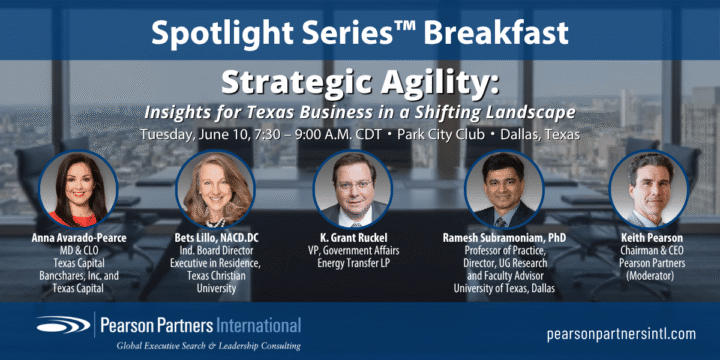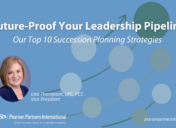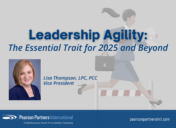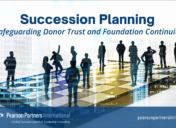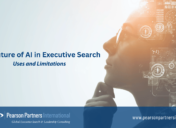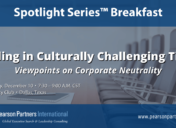Strategic Agility in a Shifting Landscape: How Texas Businesses Are Navigating Uncertainty
As Texas business leaders continue to navigate a volatile global environment, agility, resilience and clear-eyed strategy have become central to sustaining growth. At the June 10 Pearson Partners Spotlight Series™ breakfast, panelists discussed how companies across industries are managing today’s complex landscape—marked by geopolitical uncertainty, economic headwinds, regulatory flux and rapid technological evolution.
While the conversation touched on a wide range of opportunities and challenges, several consistent themes emerged: the importance of proactive risk planning, the enduring strength of the Texas economy and the need to embrace innovation, especially amid disruption.
Strategic Foresight in a Complex Landscape
Setting the tone for the discussion, one panelist noted:
“The number one question clients are asking right now is how to navigate uncertainty.”
From economic instability and fluctuating trade policies to inflation and interest rate volatility, business leaders face no shortage of risks. Yet panelists emphasized that companies cannot afford to sit still and wait for guidance.
“Scenario planning is essential,” a panelist advised. “The organizations that took time to prepare with ‘if-then’ models last year are faring far better today.” The panel discussed several risk mitigation strategies, including capital-based planning and stress-testing long-term contracts.
The conversation frequently returned to the concept of tariff whiplash, a term several panelists used to describe the ongoing unpredictability in U.S. trade policy. Rather than react defensively, forward-looking companies are embracing a more strategic approach, with many planning for inflation, buffering inventory and diversifying their product, service and supply portfolios. As one panelist said, “We are in a new world order. Tariffs are not going away, but that doesn’t mean we can’t adapt and find opportunity in the disruption.”
Meeting the Challenges Ahead
While Texas’ growth trajectory and business optimism remain strong, several panelists emphasized that continued success would depend on the state’s ability to address several persistent and emerging challenges.
As Texas experiences rapid population growth and corporate relocation, its water and power infrastructures are among the state’s most pressing challenges. As one panelist noted, “The state has been working on water access legislation for decades, but the conversation is becoming more urgent as demand rises.” Similarly, the power grid must continue to evolve to meet the demands of a growing population, increased industrial activity and the significant energy needs of AI and data center expansion.
Another key concern the panelists raised was workforce readiness. As digital transformation accelerates, there is a risk that Texas could fall behind other global innovation centers if the state does not continue to prioritize investments in education and talent upskilling/reskilling, especially for AI adoption.
“We are moving into an era where basic tasks will be automated,” a panelist observed. “We must prepare our workforce to move into higher-value roles, or we risk losing our edge to other innovation hubs, both nationally and globally.”
The panel also emphasized the crucial role of public-private partnerships in fostering innovation and resilience. Collaborations between government, academia and industry will be essential for navigating complex issues, from economic uncertainty to technological adoption and regulatory change. “Public-private partnerships are one of the most effective ways to maintain momentum while absorbing external shocks,” one panelist noted.
Other concerns mentioned included housing shortages and immigration policies, both of which directly affect Texas’ ability to attract and retain top talent. “Texas is the top U.S. trading partner with Mexico,” one panelist pointed out. “We need thoughtful immigration and trade strategies if we want to maintain our workforce and economic vitality.”
Panelists shared practical steps companies can take to mitigate these risks, including:
-
- Scenario planning
- Financial modeling
- Stakeholder engagement
- Flexible contract adoption
- Automation and AI investment
- Consistent communication
- And more
As one speaker succinctly said:
“It’s not about avoiding the storm—it’s about learning how to navigate through it.”
Texas: Resilient, Optimistic and Well-Positioned
Panelists were bullish on Texas’ long-term outlook and its readiness to mitigate these challenges. The state’s position as the eighth-largest economy in the world, together with its deep labor pool and business-friendly policies, continues to insulate it from many of the shocks felt elsewhere.
“We recently surveyed over 750 CEOs across the state,” shared one panelist. “85 percent were optimistic about Texas, while recognizing that the short term could be bumpy.”
Panelists pointed to the growing momentum behind the Texas Stock Exchange, recent business court legislation and new protections for corporate officers and directors as signs that Texas is well-poised for business growth and innovation. The panelists agreed that these changes are likely to attract even more companies to relocate to or incorporate in Texas.
“The framework is there,” a panelist noted. “With consistent regulation, supportive legislation, and the right infrastructure, we’re setting the stage for a new era of corporate growth in Texas.”
Redefining Resilience: From Cost Efficiency to Strategic Flexibility
Resilience in this environment requires more than just grit. It demands a shift in mindset. Historically, companies optimized supply chains for efficiency. Today, they must build them for adaptability.
“We’ve moved from a just-in-time mindset to a just-in-case reality,” said one panelist. “It’s not just about raw materials anymore. You must understand your entire supply network—labor, packaging, secondary suppliers—and build redundancy where possible.”
The discussion highlighted how companies are retooling legacy frameworks, such as lean manufacturing, to accommodate this new approach. One panelist shared an example of a major automaker that pioneered lean production but is now stockpiling semiconductors to ensure manufacturing continuity.
Technology plays a vital role in enabling this transformation. Panelists mentioned cloud computing, blockchain, automation and AI as tools for gaining real-time visibility and supporting strategic decision-making.
“Details matter,” a panelist emphasized. “Whether you’re talking about integrating financial and operational systems or mapping supply chain risks down to Tier 2 and Tier 3 suppliers, it’s the details that drive resilience.”
The Power of Communication and Culture
One of the most pragmatic takeaways from the event was the value of internal alignment. A panelist described his organization’s daily cross-functional meetings, likening them to a “war room,” where senior leaders in operations, legal, government affairs and investor relations share updates and anticipate regulatory shifts.
“Clear, consistent communication across the business is how we stay ahead,” the panelist explained. “It’s how we manage risk, spot opportunities and move faster.”
This internal discipline extends to external relationships as well. Scenario planning with suppliers and building flexible contract terms are essential ways to absorb shocks and maintain continuity with partners and clients.
Innovation at the Center of Growth
Texas’ legacy of innovation and its growing ecosystem of tech hubs, universities and startups featured prominently in the conversation. From renewable energy and sustainable development to autonomous transportation and smart manufacturing, panelists agreed that Texas is defined by forward-thinking enterprise.
One panelist shared her perspective on Texas’ entrepreneurial energy:
“There is a bias for action in Texas. We don’t wait for perfect conditions. We solve problems and build solutions.”
That same resilient spirit applies to AI adoption. While data quality and governance still present risks, panelists uniformly encouraged companies to embrace AI as an operational enabler.
“AI is not going away,” one panelist noted. “You may not lose your job to AI, but if you don’t understand it, you may lose it to someone who does.” Others urged leaders to experiment, invest in training and involve younger professionals who are already fluent in the tools and use cases.
What’s Next for Texas?
To wrap up the discussion, Pearson Partners Advisor Dr. Robert Potter asked our panelists to share their outlook for Texas business five years from now. All were optimistic, with some boldly predicting that the number of Fortune 500 companies headquartered in Dallas/Fort Worth alone (currently eleven) would double, driven by business-friendly initiatives and economic momentum.
One panelist best summarized the discussion:
“Texas is open for business. With the right strategy, investment and foresight in place, we are just getting started.”
Pearson Partners International helps executives and organizations navigate complex dynamics through our quarterly Spotlight Series™ events—continuing the conversation on leadership, strategy and the future of work.
Learn more about the Pearson Partners Spotlight Series™ breakfast events.

